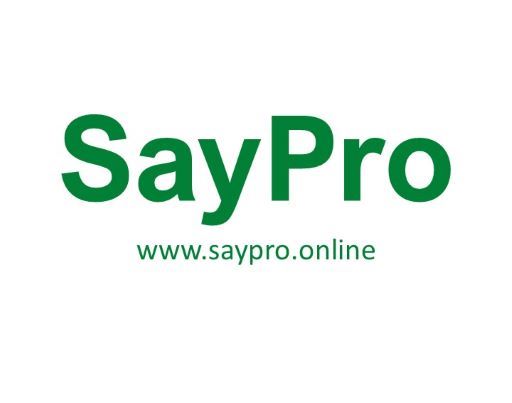SayPro Recommendation Implementation: Apply at least 3 key recommendations from the previous data analysis and track their impact on subsequent tender submissions. SayPro Monthly January SCMR-1 SayPro Monthly Data Analysis: Analyse data from previous tenders and bids by SayPro Tenders, Bidding, Quotations, and Proposals Office under SayPro Marketing Royalty SCMR
Objective:
The goal of this initiative is to apply at least three key recommendations derived from the previous data analysis to improve subsequent tender submissions. By strategically implementing these recommendations, SayPro aims to optimize the bidding process, increase win rates, and ultimately enhance overall business performance.
Key Recommendations from Data Analysis:
Based on the previous analysis, the following recommendations are identified as critical to improving tender submission success:
1. Enhance Proposal Customization Based on Client Needs
- Recommendation: Tailor each proposal to better align with the specific needs and challenges of the client. Personalize the proposals by integrating detailed insights from the client’s business model, goals, and pain points, making sure the proposal directly addresses these areas.
- Implementation Plan:
- Conduct in-depth research into the client’s business, goals, and challenges. If available, use any previous feedback or meeting notes from the sales or marketing teams to personalize the proposal.
- Engage with clients early in the process through pre-bid consultations, ensuring that the proposal is highly targeted and relevant.
- Create proposal templates that allow for easy customization, streamlining the process while ensuring personal touches.
- Impact Tracking:
- Metric: Proposal success rate (i.e., the percentage of proposals that convert into contracts).
- Tracking Method: Track how the success rate for customized proposals compares to standard or generic proposals. Monitor any improvements in win rates for tenders that have undergone this enhanced customization process.
2. Improve Bid Preparation and Submission Time Efficiency
- Recommendation: Reduce the time taken to prepare and submit bids without compromising on quality. Streamline the internal processes for gathering necessary data, approvals, and documentation to accelerate the bidding cycle.
- Implementation Plan:
- Identify bottlenecks in the current bid preparation process, such as delays in internal approvals or waiting for external documents.
- Implement new tools or software solutions for bid management that can automate data gathering, approvals, and document tracking.
- Set up regular internal meetings to ensure alignment on deadlines and responsibilities among key stakeholders involved in the bidding process.
- Impact Tracking:
- Metric: Bid preparation time (i.e., the average time from the initiation of a bid to its submission).
- Tracking Method: Monitor how much time is saved per bid in the current quarter compared to the previous quarter. Measure any improvements in meeting deadlines or reducing delays in the bid preparation process.
3. Leverage Competitive Intelligence for Better Pricing and Positioning
- Recommendation: Use competitive intelligence to better position SayPro’s bids in relation to competitors. This includes analyzing competitor pricing strategies, their proposal strengths, and weaknesses, and identifying gaps that SayPro can capitalize on.
- Implementation Plan:
- Regularly gather data on competitors’ tenders, bids, and proposals through public sources, industry reports, and market intelligence platforms.
- Establish a framework for analyzing competitors’ pricing and offering structures. Use this information to adjust pricing strategies and differentiate SayPro’s value propositions more effectively.
- Coordinate with the marketing and sales teams to refine the messaging, ensuring that it clearly articulates SayPro’s unique strengths compared to competitors.
- Impact Tracking:
- Metric: Bid conversion rate and client feedback on pricing competitiveness.
- Tracking Method: Analyze win rates for bids where competitive intelligence has been used to refine the proposal. Also, gather client feedback to evaluate how competitive and attractive SayPro’s pricing structure appears compared to competitors.
Monitoring and Evaluation Process:
To ensure that the implemented recommendations are having a positive impact on tender submissions, the following tracking and evaluation steps will be taken:
- Quarterly Review:
- Conduct a quarterly review of all tender submissions and their outcomes. Compare the performance of tenders where the new recommendations were applied with those that followed the previous approach.
- Data Analytics Dashboard:
- Utilize an analytics dashboard to track the key metrics for each recommendation (e.g., proposal success rate, bid preparation time, bid conversion rate).
- Set up real-time monitoring of these metrics to quickly identify trends and determine if changes are having the desired impact.
- Client Feedback and Follow-ups:
- After submission, track client feedback and follow-up responses related to the customized proposals and competitive pricing. This will provide valuable qualitative data to understand the impact of the changes from the client’s perspective.
- Internal Team Feedback:
- Gather feedback from the teams involved in bid preparation and submission (e.g., marketing, sales, and proposal teams). This feedback will help assess how well the process changes are working on the operational side and identify any issues that need addressing.
Expected Outcomes:
By applying these key recommendations, SayPro expects to see the following outcomes:
- Increased Win Rate:
- A higher success rate in tenders due to more relevant, customized proposals and more competitive pricing strategies.
- Faster Bid Submission Times:
- Reduced delays and improved efficiency in bid preparation, allowing for more timely submissions and less stress in meeting deadlines.
- More Competitive Proposals:
- Enhanced ability to position SayPro’s proposals favorably in comparison to competitors, resulting in higher bid conversion rates and a stronger market presence.
- Improved Client Engagement:
- Better client satisfaction due to more targeted proposals, effective engagement, and a clear understanding of their needs, which should increase the chances of winning contracts.
Conclusion:
The strategic application of these three recommendations—enhancing proposal customization, improving bid preparation efficiency, and leveraging competitive intelligence—aims to significantly improve SayPro’s success rates in tender submissions. Tracking their impact will involve rigorous analysis of key performance metrics and client feedback, ensuring that the implementation of these recommendations is data-driven and results-focused. By consistently monitoring the effects of these improvements, SayPro can refine its approach and increase its win rate, ultimately driving growth and success in the marketplace.
